What’s Leaking Under My Car?
Our cars rely on different fluids to run properly. Gas or diesel to power combustion, oil for lubricating components, coolant to keep the engine at a safe temperature, and hydraulic fluid for the brakes and power steering. Generally speaking, the fluids that keep your car running should not be seen outside their specific enclosed systems. If something is leaking under your car, it usually means there is a problem. To the untrained eye, identifying what is leaking under your car can be a challenge.
Luckily, each fluid has a somewhat distinct appearance that can help you identify what mysterious liquid is dripping from your vehicle.
While this guide may help you figure out where or what is leaking, you should always consult a trusted automotive expert’s opinion if you’re experiencing a fluid leak.
Possible Fluids Leaking From My Car (And How to Identify Them!)
Clear/Water
If you notice a puddle of odorless clear liquid under your vehicle, there’s a good chance that’s just water. This is especially true in the summer, as water coming from your vehicle is often condensation from the air conditioning unit that is expelled under the vehicle.
While harmless, you should be extra sure it’s truly just water before choosing to ignore it.

Iridescent/Yellow/Brown
If you see a puddle with a multicolored sheen, there’s a good chance you’re looking at gasoline or diesel.
It should have a lightly brown tone when soaked up with a paper towel, and will have the strong and distinct smell of a gas station (let’s be honest, you know what gasoline smells like).
If you encounter this puddle under your parked car, you should avoid driving the vehicle and have it towed to a professional for an inspection. Driving with a fuel leak can be extremely risky, if the leak is dripping fuel on the hot engine and exhaust components, it may combust and start a fire in your vehicle.
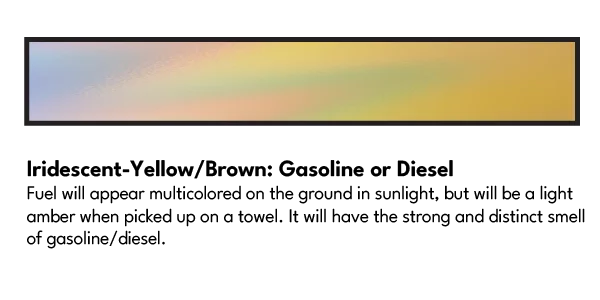
Red/Brown
A puddle of reddish-brown fluid under your vehicle most likely means you have a transmission fluid leak.
Transmission fluid is responsible for lubricating and cooling the internal components of your transmission. Running with low or no transmission fluid can be catastrophic for your gearbox, which is why these leaks should always be taken very seriously. So when you see a red puddle under the general location of your transmission, you should immediately check your dipstick. If low on fluid, do not drive the vehicle and arrange to have your leak diagnosed and repaired.
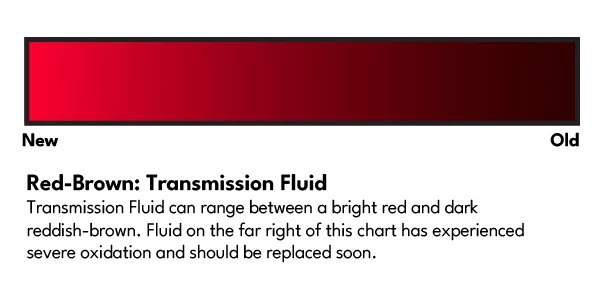
Red/Pink/Brown
Power steering fluid also comes red, but generally has a more brown tone to it. You can also differentiate it from transmission fluid by its sweet or slightly burnt smell (think burnt marshmallow). If you suspect power steering fluid, check your reservoir in the engine bay and ensure it’s within the min-max levels. If it has fallen below this line, avoid driving before addressing the issue, as there’s the potential to permanently damage your power steering pump.
If the leak is slow and your reservoir is still sufficiently filled, nothing is stopping you from driving. However, you should take care of the issue as soon as possible and monitor the level regularly.
It should also be noted that some specific vehicles use red coolant instead of the traditional green/yellow coolant. We’ll cover identifying and the effects of a coolant leak later. While less common, ensure you rule this out before taking other measures.
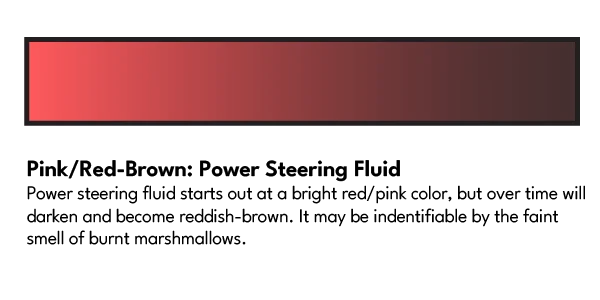
Brown/Black
Oil is probably the most common type of leak in a vehicle. Responsible for lubricating your engine components, oil is also one of the most important fluids.
Oil will appear anywhere from amber to a deep brown/black color. It will leave a slick and oily (surprising, we know) feel on your hands and noticeable stains anywhere it lands.
Leaks can range from relatively harmless to catastrophic. Without proper lubrication, The metal components in your engine will become damaged, leading to costly repairs.. Keep an eye on your oil pressure light if you have a known oil leak, and regularly check that the fluid level is within the healthy range on your dipstick. Top off with the proper oil as needed until you’re able to have your leak repaired.
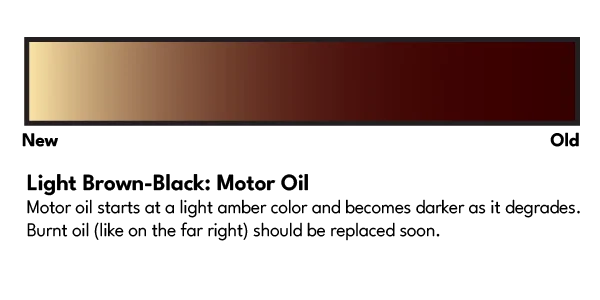
Clear/Yellow/Brown
Another fluid you really wouldn’t want to run without is brake fluid. Brake fluid provides the hydraulic pressure needed to safely stop your vehicle.
The color of brake fluid can range from an almost clear yellow-brown tinted liquid to the same amber color as motor oil. Brake fluid will be slick and have a distinct fishy smell.
You may find these leaks around your wheels or under your brake lines. If you notice leaking brake fluid, do not drive the vehicle as you may lose all ability to stop. On most cars, the brake fluid reservoir can be found in the engine bay, directly in front of the driver. Check and see if the brake fluid is within the min/max zone on the reservoir. Have it towed to a professional for repair before driving the vehicle again.
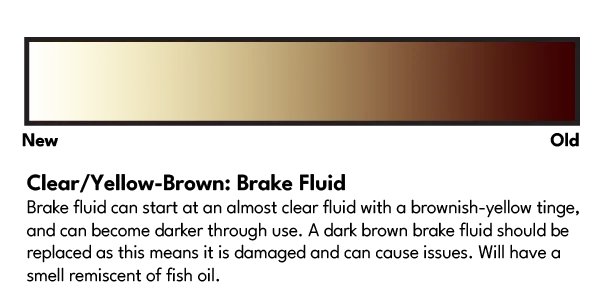
Yellow/Green/Red/Orange/Blue/Pink
If your leak looks more like snowcone syrup than an automotive fluid, you’re most likely looking at coolant.
Coolant, sometimes known as antifreeze, is the fluid used to maintain a healthy temperature in your engine. It’s looped through the cooling system, draws heat from the motor, and is returned to the radiator to be cooled and looped again.
The color of your vehicle’s coolant depends on make and model, and it comes in just about any color under the sun. Most brightly colored and translucent fluids leaking under your vehicle are likely to be coolant. It will also be identifiable by its strong sweet smell.
Coolant leaks can vary in severity, but significant leaks can cause irreparable damage if the vehicle is allowed to overheat. Always ensure your engine temperature is in a healthy range and that your coolant is at the proper level.
It should also be noted that despite its sweet smell and candy appearance, coolant is very toxic, especially to animals. If you notice a puddle of coolant on your driveway, clean it up immediately before your (or somebody else’s) pet wanders over and mistakes it for a sweet treat.
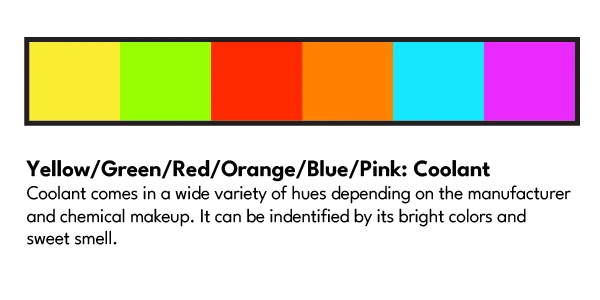
Leak Diagnostics at Borst Auto
Whether the leak under your car is coming from condensation or a punctured oil pan, the technicians at Borst Automotive will get to the bottom of it. With locations in Tucson, Phoenix, and Mesa Arizona, our shops are conveniently located and easy to find. Give us a call or schedule an appointment online today!

Borst Automotive is here to help when you need it. Give us a call, schedule an appointment, or stop in today!
